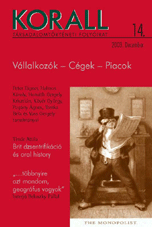A magyar malomipar finanszírozása (1895–1913)
The Financing of the Hungarian Mill Industry (1895–1913)
Author(s): Béla TomkaSubject(s): History
Published by: KORALL Társadalomtörténeti Egyesület
Keywords: Hungary; economic history; 19th–20th century; mill industry; bank; balance; joint-stock company; capital; firm
Summary/Abstract: The study provides some of the characteristic features of the financing and sources of capital of the Hungarian mill industry around the turn of the century (1895–1913). The basis of the analysis is a sample of financial data of big mills of the capital and of some smaller mills of the county. Undoubtedly, mill industry, especially the big mills in Budapest were in a special situation within the industry as a whole in this period. The mills of the capital, primarily producing for export, achieved a significant growth during the 1890’s, while in the period under survey, they rather stagnated in consequence of changed foreign market conditions and the shift of direction in Hungarian economic policy. Results allow some careful conclusions that, in turn, call for further evidence. According to results, the process of accumulation of capital developed in a more complex way in the mill industry than in heavy industry firms during the turn of the century. Concerning mills, the indexes based on the application of sources of credit clearly show the growth of loans outstanding. On the one hand, one can state that mills increasingly made use of external sources, especially in the period until 1904. At the same time, the indexes measuring the internal capacity of capital accumulation also show either slight improvement or stagnation. This seemingly conflicting dynamics might be related to the characteristics of the technological- financial development of the mill industry: the growth of “fixed capital” within the “capital” increasingly slowed down, moreover, the proportion of “deductions” and “reserves” slightly grew. Apart from this, another important factor is that external sources were decisively not banks, it rather seems that tradesmen in business contact with mills gave credit to firms. Generally, the financial situation and policy of individual mill industry firms significantly differed: some companies had high bank credits, while other big mills were counted as net creditors of banks.
Journal: Korall - Társadalomtörténeti folyóirat
- Issue Year: 2003
- Issue No: 14
- Page Range: 79-97
- Page Count: 19
- Language: Hungarian

